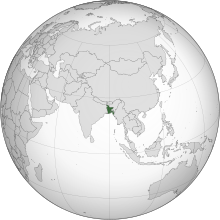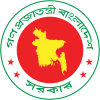
Back Бангладеш Abkhazian Bangladèsh ACE Бангладеш ADY Bangladesj Afrikaans Bangladesch ALS ባንግላዴሽ Amharic Bangladesh AMI Bangladesh AN Bængladesc ANG बांग्लादेश ANP
People's Republic of Bangladesh | |
|---|---|
| Anthem: আমার সোনার বাংলা (Bengali) Amar Sonar Bangla ("My Golden Bengal") | |
| Government Seal | |
 | |
| Capital and largest city | Dhaka 23°45′50″N 90°23′20″E / 23.76389°N 90.38889°E |
| Official language and national language | Bengali[1][2] |
| Recognised foreign language | English[3] |
| Ethnic groups (2022 census)[4] | 99% Bengali |
| Religion | |
| Demonym(s) | Bangladeshi |
| Government | Unitary parliamentary republic under an interim government |
| Mohammed Shahabuddin | |
| Muhammad Yunus | |
| Syed Refaat Ahmed | |
| Legislature | Jatiya Sangsad |
| Independence from Pakistan | |
| 14–15 August 1947 | |
| 5 February 1966 | |
| 7 December 1970 | |
| 26 March 1971 | |
| 10 April 1971 | |
• Victory | 16 December 1971 |
| 16 December 1972 | |
| Area | |
• Total | 148,460[8] km2 (57,320 sq mi) (92nd) |
• Water (%) | 6.4 |
• Land area | 130,170 km2[8] |
• Water area | 18,290 km2[8] |
| Population | |
• 2022 census | 169,828,911[9][10] (8th) |
• Density | 1,165/km2 (3,017.3/sq mi) (13th) |
| GDP (PPP) | 2024 estimate |
• Total | |
• Per capita | |
| GDP (nominal) | 2024 estimate |
• Total | |
• Per capita | |
| Gini (2022) | high inequality |
| HDI (2022) | medium (129th) |
| Currency | Taka (৳) (BDT) |
| Time zone | UTC+6 (BST) |
| Drives on | left |
| Calling code | +880 |
| ISO 3166 code | BD |
| Internet TLD | .bd .বাংলা |
Bangladesh,[a] officially the People's Republic of Bangladesh,[b] is a country in South Asia. It is the eighth-most populous country in the world and among the most densely populated with a population of 170 million in an area of 148,460 square kilometres (57,320 sq mi). Bangladesh shares land borders with India to the north, west, and east, and Myanmar to the southeast. To the south, it has a coastline along the Bay of Bengal. It is separated from Bhutan and Nepal by the Siliguri Corridor, and from China by the mountainous Indian state of Sikkim. Dhaka, the capital and largest city, is the nation's political, financial, and cultural centre. Chittagong is the second-largest city and the busiest port. The official language is Bengali, with Bangladeshi English also used in government.
Bangladesh is part of the historic and ethnolinguistic region of Bengal, which was divided during the Partition of British India in 1947 as the eastern enclave of the Dominion of Pakistan, from which it gained independence in 1971 after a bloody war.[17] The country has a Bengali Muslim majority. Ancient Bengal was known as Gangaridai and was a stronghold of pre-Islamic kingdoms. The Muslim conquest after 1204 led to the sultanate and Mughal periods, during which an independent Bengal Sultanate and wealthy Mughal Bengal transformed the region into an important centre of regional affairs, trade, and diplomacy. The Battle of Plassey in 1757 marked the beginning of British rule. The creation of Eastern Bengal and Assam in 1905 set a precedent for the emergence of Bangladesh. The All-India Muslim League was founded in Dhaka in 1906.[18] The Lahore Resolution in 1940 was supported by A. K. Fazlul Huq, the first Prime Minister of Bengal. The present-day territorial boundary was established with the announcement of the Radcliffe Line.
In 1947, East Bengal became the most populous province in the Dominion of Pakistan and was renamed East Pakistan, with Dhaka as the legislative capital. The Bengali Language Movement in 1952, the 1958 Pakistani coup d'état, and the 1970 Pakistani general election spurred Bengali nationalism and pro-democracy movements. The refusal of the Pakistani military junta to transfer power to the Awami League, led by Sheikh Mujibur Rahman, triggered the Bangladesh Liberation War in 1971. The Mukti Bahini, aided by India, waged a successful armed revolution; the conflict saw the Bangladeshi genocide. The new state of Bangladesh became a constitutionally secular state in 1972, although Islam was declared the state religion in 1988.[19] In 2010, the Bangladesh Supreme Court reaffirmed secular principles in the constitution.[20] The Constitution of Bangladesh officially declares it a socialist state.[21]
A middle power in the Indo-Pacific,[22] Bangladesh is home to the fifth-most spoken native language, the third-largest Muslim-majority population, and the second-largest economy in South Asia. It maintains the third-largest military in the region and is the largest contributor to UN peacekeeping operations.[23] Bangladesh is a unitary parliamentary republic based on the Westminster system. Bengalis make up almost 99% of the population.[24] The country consists of eight divisions, 64 districts, and 495 subdistricts, and includes the world's largest mangrove forest. Bangladesh hosts one of the largest refugee populations due to the Rohingya genocide.[25] Bangladesh faces challenges like corruption, political instability, overpopulation, and effects of climate change. Bangladesh has twice chaired the Climate Vulnerable Forum and hosts the Bay of Bengal Initiative for Multi-Sectoral Technical and Economic Cooperation (BIMSTEC) headquarters. It is a founding member of the South Asian Association for Regional Cooperation (SAARC) and a member of the Organization of Islamic Cooperation and the Commonwealth of Nations.
- ^ "The Constitution of the People's Republic of Bangladesh". Ministry of Law, Justice and Parliamentary Affairs. Archived from the original on 10 November 2019. Retrieved 1 February 2017.
- ^ বাংলা ভাষা প্রচলন আইন, ১৯৮৭ [Bengali Language Implementation Act, 1987]. bdlaws.minlaw.gov.bd (in Bengali). Ministry of Law, Justice and Parliamentary Affairs. Archived from the original on 7 January 2024. Retrieved 7 January 2024.
- ^ Historical Evolution of English in Bangladesh (PDF). Mohammad Nurul Islam. 1 March 2019. pp. 9–. Archived (PDF) from the original on 5 February 2024. Retrieved 10 November 2023.
- ^ "Ethnic population in 2022 census" (PDF).
- ^ "Census data confirm decline of Bangladesh's religious minorities". asianews.it. Archived from the original on 7 February 2024. Retrieved 7 February 2024.
- ^ The Constitution of the People's Republic of Bangladesh ( ACT NO. OF 1972 ). (n.d.). In Bangladesh. Retrieved 13 June 2023, from http://bdlaws.minlaw.gov.bd/act-367/section-24549.html Archived 17 January 2021 at the Wayback Machine
- ^ "Population of minority religions decrease further in Bangladesh". The Business Standard. 27 July 2022. Archived from the original on 5 May 2023. Retrieved 6 February 2024.
- ^ a b c "Bangladesh". The World Factbook (2024 ed.). Central Intelligence Agency. Retrieved 13 November 2021. (Archived 2021 edition.)
- ^ "Population and Housing Census 2022: Post Enumeration Check (PEC) Adjusted Population" (PDF). Bangladesh Bureau of Statistics. 18 April 2023. Archived (PDF) from the original on 30 May 2023. Retrieved 30 May 2023.
- ^ "Report: 68% Bangladeshis live in villages". Dhaka Tribune. 28 November 2023. Archived from the original on 6 February 2024. Retrieved 6 February 2024.
- ^ "Download World Economic Outlook database: April 2023". International Monetary Fund – IMF. Archived from the original on 4 December 2023. Retrieved 4 December 2023.
- ^ "Download World Economic Outlook database: April 2023". International Monetary Fund – IMF. Archived from the original on 4 December 2023. Retrieved 4 December 2023.
- ^ "Download World Economic Outlook database: April 2023". IMF. Archived from the original on 4 December 2023. Retrieved 4 December 2023.
- ^ "Download World Economic Outlook database: April 2023". IMF. Archived from the original on 4 December 2023. Retrieved 4 December 2023.
- ^ "KEY FINDINGS HIES 2022" (PDF) (Press release). Bangladesh Bureau of Statistics. p. 15. Archived (PDF) from the original on 30 May 2023. Retrieved 13 April 2023.
- ^ Nations, United (13 March 2024). "Human Development Report 2023-24". Archived from the original on 18 March 2024. Retrieved 18 March 2024 – via hdr.undp.org.
- ^ Frank E. Eyetsemitan; James T. Gire (2003). Aging and Adult Development in the Developing World: Applying Western Theories and Concepts. Greenwood Publishing Group. p. 91. ISBN 978-0-89789-925-3. Archived from the original on 2 September 2024. Retrieved 25 July 2023.
- ^ "Muslim League – Banglapedia". Archived from the original on 20 March 2024. Retrieved 20 March 2024.
- ^ "Bangladesh profile – Timeline". BBC News. 26 February 2019. Archived from the original on 12 May 2023. Retrieved 10 January 2022.
- ^ "Bangladesh" (PDF). U.S. State Department. Archived (PDF) from the original on 9 October 2022. Retrieved 7 November 2016.
- ^ "Article Preamble, Section Preamble" (PDF). Constitution of the People's Republic of Bangladesh. 4 November 1972.
- ^ "A rising Bangladesh starts to exert its regional power". The Interpreter. Lowyinstitute.org. 21 February 2019. Archived from the original on 31 March 2022. Retrieved 10 January 2022.
- ^ "Contribution of Uniformed Personnel to UN by Country and Personnel Type" (PDF). United Nations. 4 April 2023. Archived (PDF) from the original on 12 May 2023. Retrieved 12 May 2023.
- ^ Roy, Pinaki; Deshwara, Mintu (9 August 2022). "Ethnic population in 2022 census: Real picture not reflected". The Daily Star. Archived from the original on 9 August 2022. Retrieved 11 August 2022.
- ^ Mahmud, Faisal. "Four years on, Rohingya stuck in Bangladesh camps yearn for home". Al Jazeera. Archived from the original on 5 June 2022. Retrieved 10 January 2022.
Cite error: There are <ref group=lower-alpha> tags or {{efn}} templates on this page, but the references will not show without a {{reflist|group=lower-alpha}} template or {{notelist}} template (see the help page).


